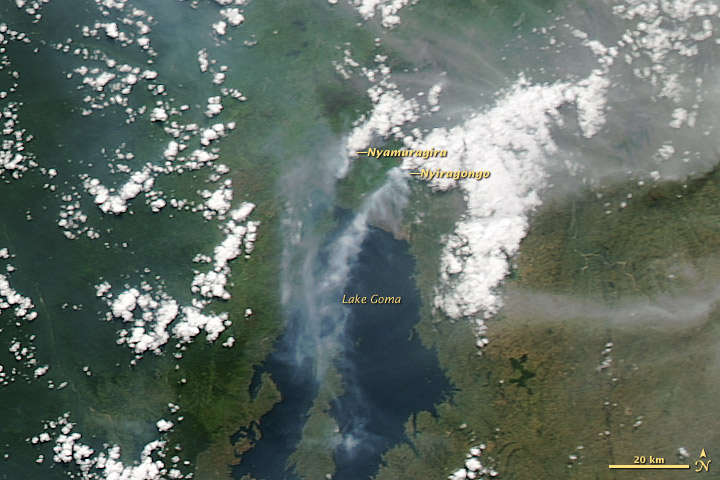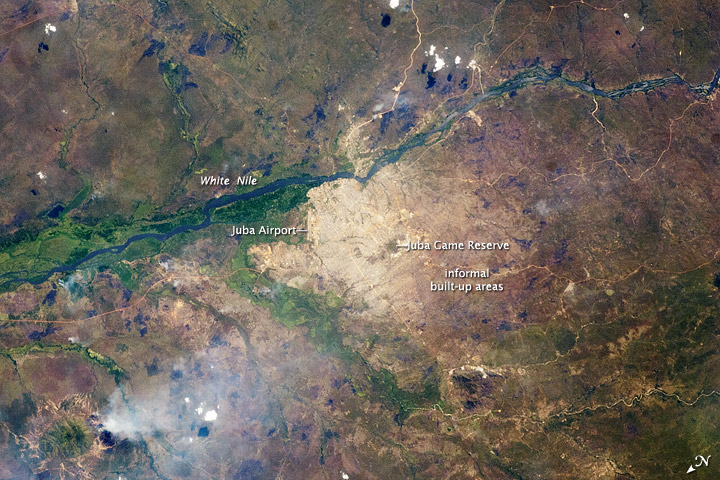NASA: Africa - Democratic Republic of Congo - Vigorous Plume from Nyiragongo Volcano - Republic of South Sudan - The World’s Newest Capital City - 07.07.12
Posted by Ricardo Marcenaro | Posted in NASA: Africa - Democratic Republic of Congo - Vigorous Plume from Nyiragongo Volcano - Republic of South Sudan - The World’s Newest Capital City - 07.07.12 | Posted on 21:40

acquired July 5, 2012
download large image (302 KB, JPEG, 800x1000)
Africa’s Mount Nyiragongo—one of the few volcanoes with a permanent lava lake—recently experienced a surge in activity. Since July 3rd, the Toulouse Volcanic Ash Advisory Center
(VAAC) reported a series of ash plumes up to an altitude of 18,000 feet
(5,500 meters), which is about 6,500 feet (2,000 m) above the volcano’s
11,384-foot (3,470 m) summit. Nyiragongo frequently emits sulfur dioxide,
but ash emissions are unusual. This natural-color satellite image shows
emissions streaming southwest from Nyiragongo, with an additional plume
from nearby Nyamuragira. This image was acquired by the Moderate Resolution Imaging Spectroradiometer (MODIS) aboard the Aqua satellite on July 5, 2012.
Reference
- Toulouse Volcanic Ash Advisory Center. (2012, July 5). VA Advisory. Accessed July 5, 2012.
NASA image courtesy Jeff Schmaltz, LANCE MODIS Rapid Response Team, GSFC.
- Instrument:
- Aqua - MODIS
Monte Nyiragongo

acquired November 26, 2011
download large image (597 KB, JPEG, 1440x960)
Almost one year ago, on July 9, 2011,
the Republic of South Sudan became the newest nation in the world, six
months after its declaration of independence from Sudan. Juba, a port
city on the White Nile, is the capital of the new nation and is one of
the fastest growing cities in the world. Juba’s population is
uncertain, but it is estimated to be roughly 350,000 to 400,000. The
city has doubled in size since 2005, when a peace agreement ended the
civil war in Sudan. Both hopeful immigrants and returning residents have
created the population surge.
The city was a central point for humanitarian aid, and the operations base for the United Nations and non-governmental organizations during the Sudanese conflicts. Today, a significant number of foreign aid workers remain in the city. During the conflict, city infrastructure and main transportation arteries suffered heavy damage. The city is still surrounded by army camps and squatter settlements (labeled “informal built-up areas” in the image). They appear as muted gray areas extending outward from the center of the city.
The city also hosts the Juba Game Reserve, a protected area of savannah and woodlands that is home to key bird species. Since independence, a variety of countries and international organizations have helped rebuild Juba’s roads, railroads, and airport. Unfortunately, South Sudan continues to experience local wars with a variety of armed groups, including on-going conflicts with Sudan over oil-rich territories.
The city was a central point for humanitarian aid, and the operations base for the United Nations and non-governmental organizations during the Sudanese conflicts. Today, a significant number of foreign aid workers remain in the city. During the conflict, city infrastructure and main transportation arteries suffered heavy damage. The city is still surrounded by army camps and squatter settlements (labeled “informal built-up areas” in the image). They appear as muted gray areas extending outward from the center of the city.
The city also hosts the Juba Game Reserve, a protected area of savannah and woodlands that is home to key bird species. Since independence, a variety of countries and international organizations have helped rebuild Juba’s roads, railroads, and airport. Unfortunately, South Sudan continues to experience local wars with a variety of armed groups, including on-going conflicts with Sudan over oil-rich territories.
Astronaut photograph ISS030-E-5199
was acquired on November 26, 2011, with a Nikon D2Xs digital camera
using a 145 mm lens, and is provided by the ISS Crew Earth Observations
experiment and Image Science & Analysis Laboratory, Johnson Space
Center. The image was taken by the Expedition 30 crew. It has been cropped and enhanced to improve contrast, and lens artifacts have been removed. The International Space Station Program supports the laboratory as part of the ISS National Lab
to help astronauts take pictures of Earth that will be of the greatest
value to scientists and the public, and to make those images freely
available on the Internet. Additional images taken by astronauts and
cosmonauts can be viewed at the NASA/JSC Gateway to Astronaut Photography of Earth. Caption by Cynthia A. Evans at NASA-JSC.
- Instrument:
- ISS - Digital Camera
NASA: Africa - Democratic Republic of Congo - Vigorous Plume from Nyiragongo Volcano - Republic of South Sudan - The World’s Newest Capital City - 07.07.12
Ricardo M Marcenaro - Facebook
Operative blogs of The Solitary Dog:
solitary dog sculptor:
http://byricardomarcenaro.blogspot.com
Solitary Dog Sculptor I:
http://byricardomarcenaroi.blogspot.com
Para:
comunicarse conmigo,
enviar materiales para publicar,
propuestas:
marcenaroescultor@gmail.com
For:
contact me,
submit materials for publication,
proposals:
marcenaroescultor@gmail.com
Diario La Nación
Argentina
Cuenta Comentarista en el Foro:
Capiscum
My blogs are an open house to all cultures, religions and countries. Be a follower if you like it, with this action you are building a new culture of tolerance, open mind and heart for peace, love and human respect.
Thanks :)
Mis blogs son una casa abierta a todas las culturas, religiones y países. Se un seguidor si quieres, con esta acción usted está construyendo una nueva cultura de la tolerancia, la mente y el corazón abiertos para la paz, el amor y el respeto humano.
Gracias :)


Comments (0)
Publicar un comentario